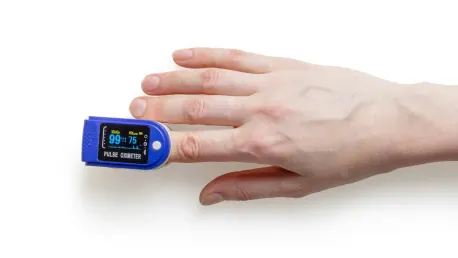Pulse oximeters have become an essential tool in healthcare, especially during the COVID-19 pandemic, for monitoring blood oxygen levels. These small devices utilize light to estimate the amount of oxygen in the blood, assisting clinicians in making critical decisions regarding patient care. However, concerns about the accuracy of these devices for individuals with dark skin pigmentation have raised important questions about their reliability across diverse populations.
Historical Context and Ongoing Issues
Long-Standing Discrepancies
Inaccuracy issues with pulse oximeters have long been a topic of discussion within the medical community. Since as early as 1990, studies have suggested that these devices may not reliably measure oxygen saturation levels in people with darker skin tones. This is due to the technology’s reliance on light absorption, which can be affected by higher melanin levels in the skin. Despite advancements in medical technology, this gap in accuracy persists, leading to pressing questions about the effectiveness of pulse oximeters for everyone.
The recent COVID-19 pandemic brought these discrepancies into sharper focus. The severe respiratory symptoms associated with COVID-19 made accurate monitoring of blood oxygen levels crucial. A pivotal study conducted by Johns Hopkins University found that pulse oximeters tended to overestimate oxygen saturation in Black and Hispanic patients. This overestimation delayed necessary treatments for these individuals, highlighting the vital need for improvements in device accuracy. These findings prompted healthcare experts to advocate for a revision in how pulse oximeters are tested and evaluated to ensure they serve all populations equitably.
Impact of COVID-19
The COVID-19 pandemic exacerbated long-standing concerns about pulse oximeter accuracy and brought them to the forefront of public health discussions. As the pandemic spread, pulse oximeters became a common household item. Many patients used them to monitor their oxygen levels at home, seeking medical help when the readings indicated a drop in oxygen saturation. However, inaccuracies in these readings for darker-skinned individuals raised alarms, as it became clear that these devices could not be wholly trusted to provide accurate assessments for everyone.
The Johns Hopkins study underscored the real-world consequences of these inaccuracies. It showed that Black and Hispanic patients might receive delayed access to life-saving treatments because their oxygen levels were falsely inflated. This delay in treatment eligibility could potentially lead to worse outcomes. The study’s findings demonstrate the urgent need to address these inaccuracies and ensure that pulse oximeters are reliable for all patients, regardless of skin tone. The pandemic’s unprecedented nature served as a catalyst for further investigation into these devices’ performance, ultimately leading to renewed calls for regulatory oversight and improvement.
FDA’s Draft Guidance
Proposed Changes
In response to these findings, the Food and Drug Administration (FDA) issued a draft guidance in January aimed at addressing the inaccuracies of pulse oximeters. One of the key proposed changes is significantly increasing the number of study participants in clinical trials. The new guidelines recommend expanding the pool from 10 participants to 150. This increase would allow for a more diverse range of skin tones to be included in the testing process, providing a better understanding of how these devices perform across different populations.
The FDA’s draft guidance also calls for detailed protocols to evaluate pulse oximeters’ performance among varied skin pigmentation. This would involve specific methodologies to assess how different levels of melanin in the skin affect the devices’ readings. By incorporating these protocols, the FDA aims to ensure that the devices provide accurate readings for all patients, irrespective of their skin color. These proposed changes are a significant step forward in addressing the long-standing issue of pulse oximeter bias, highlighting the need for comprehensive testing and evaluation.
Support and Concerns
While the FDA’s draft guidance has been welcomed and seen as a step in the right direction, it also faces substantial hurdles that could impede its progress. One of the primary concerns is the current political climate under the Trump administration, which has shown resistance to diversity and inclusion initiatives. This stance raises legitimate questions about the administration’s commitment to implementing stricter guidelines that prioritize equitable healthcare for all populations.
Trump’s executive order to end diversity, equity, and inclusion programs adds an additional layer of complexity. These programs are crucial for ensuring that medical devices like pulse oximeters are tested and designed to be inclusive and effective for everyone. Given the administration’s stance, there is a substantial risk that the FDA’s proposed guidance might stall, delaying much-needed improvements. This potential stalling of progress is troubling for healthcare advocates who emphasize the importance of accurate medical devices in providing equitable treatment to all patients, regardless of their skin tone.
Expert Opinions
Academic Perspectives
Academics and researchers have long stressed the importance of addressing pulse oximeter bias to enhance healthcare delivery. Kadija Ferryman, an Assistant Professor at Johns Hopkins University, has been vocal about the necessity of tackling these inaccuracies. Ferryman emphasizes that eliminating the bias in pulse oximeter readings could lead to substantial improvements in healthcare outcomes. Accurate readings are vital for timely medical interventions, and any discrepancies can lead to delayed treatments, as evidenced during the COVID-19 pandemic.
Ferryman argues that frequent updates to the FDA’s guidance are crucial to ensure these devices remain relevant and accurate. As medical technology continues to advance, guidelines must evolve to reflect new knowledge and capabilities. Regular revisions to testing methodologies and evaluation criteria can help mitigate biases and improve the reliability of pulse oximeters for diverse populations. Ferryman’s perspective underscores the critical role of continuous research and adaptation in ensuring medical devices meet the highest standards of accuracy and equity.
Dermatological Insights
Jenna Lester, an Associate Professor of Dermatology at the University of California, San Francisco, echoes similar sentiments, emphasizing the need for continuous updates and enhancements to the FDA’s guidance. Lester points out that skin tone can significantly affect the accuracy of pulse oximeters, and regular updates to the standards are necessary to keep up with medical and technological advancements. She believes that only through ongoing improvements can the devices provide reliable readings for all individuals, contributing to more effective and equitable healthcare.
Lester also highlights the importance of comprehensive testing and inclusive clinical trials. Ensuring that diverse populations are adequately represented in these trials is essential for understanding how different skin tones impact device performance. By incorporating a broader range of participants, researchers can identify and address potential biases, leading to more accurate and trustworthy medical devices. Lester’s insights reinforce the idea that achieving equity in healthcare requires a concerted effort to continually refine and improve the tools and technologies used in patient care.
Industry Response
Company Stances
Leading manufacturers of pulse oximeters, such as Medtronic and Masimo, have recognized the importance of the FDA’s efforts to improve device accuracy and have expressed their support. Medtronic, a prominent player in the medical device industry, asserts confidence in the accuracy and performance of its pulse oximeters. The company maintains that their devices undergo rigorous testing to meet high standards and provide reliable readings for all patients, regardless of skin tone.
However, Medtronic acknowledges that there is always room for improvement. The company is committed to continually evaluating and enhancing its products to ensure they meet the needs of diverse populations. This includes supporting the FDA’s proposed changes and participating in further research to better understand how pulse oximeters can be optimized for accuracy across different skin tones. Medtronic’s stance highlights the industry’s recognition of the issue and its willingness to collaborate with regulatory bodies to achieve more equitable healthcare outcomes.
Commitment to Improvement
Masimo, another leading manufacturer, has also shown a strong commitment to addressing the discrepancies in pulse oximeter accuracy. The company has been proactive in conducting studies to evaluate the performance of its devices among varied skin tones. While Masimo is confident in the quality of its products, it recognizes the need for ongoing research and improvement. The company supports the FDA’s draft guidance and is dedicated to ensuring its devices provide accurate readings for all patients.
Both Medtronic and Masimo emphasize their commitment to maintaining high standards of accuracy and reliability for their pulse oximeters. They actively engage with the medical community and regulatory bodies to identify and address any potential biases in their devices. These companies’ efforts to enhance their products reflect a broader industry trend toward improving healthcare equity. By focusing on continuous improvement and inclusive testing, they aim to build trust among patients and healthcare providers, ensuring that pulse oximeters are effective for everyone.
Patient and Healthcare Impact
Trust and Accuracy
Patients, particularly those with darker skin tones, have voiced concerns about the accuracy of pulse oximeters, and these concerns impact their trust in these devices and their healthcare providers. When patients are unsure about the reliability of a medical device, it can lead to anxiety and hesitation in seeking timely medical care. This lack of trust can have serious consequences, especially in situations where prompt and accurate readings are critical for determining the appropriate course of treatment.
Ensuring the accuracy of pulse oximeters across all skin tones is not just a matter of technology, but also one of patient confidence and safety. When patients believe in the reliability of their medical devices, they are more likely to follow medical advice and seek care when needed, leading to better health outcomes. Addressing the biases in pulse oximeters is essential for building and maintaining this trust, which is a cornerstone of effective healthcare.
Necessity of Reliable Readings
Pulse oximeters have emerged as a vital device in healthcare, particularly during the COVID-19 pandemic, for tracking blood oxygen levels. These compact gadgets use light beams to gauge the oxygen saturation in a person’s blood, aiding healthcare professionals in making critical judgments about patient treatment. One of the key benefits of pulse oximeters is their ability to quickly provide information about a patient’s respiratory efficiency, which can be crucial in acute and chronic conditions. However, increasing scrutiny has been directed towards the accuracy of these devices for individuals with darker skin tones. Studies suggest there may be discrepancies in readings, which could have significant implications for patient care in various demographics. This has raised important discussions about the reliability of pulse oximeters across different populations, emphasizing the need for further research and possibly re-engineering the technology to ensure equitable healthcare for all.









